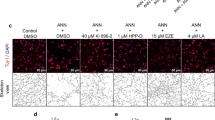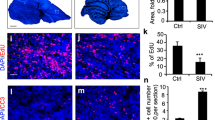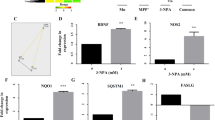Abstract
A fungal strain able to naturally accumulate large amounts of monacolin J was improved by N-methyl-N′-nitro-N-nitrosoguanidine mutagenesis and genetic disruption of the lovF gene. Semisynthesis was then used to produce novel statins by attaching different side chains at the C8 hydroxyl residue. In vitro hypocholesterolemic and neuroprotection assays showed that one derivative (NST0037) had a very low 3-hydroxy-3-methylglutaryl CoA reductase IC50 and high protection rate for oxidative-stress-induced neuron cell death.
Similar content being viewed by others
Log in or create a free account to read this content
Gain free access to this article, as well as selected content from this journal and more on nature.com
or
Accession codes
References
Shindia, A. A. Mevinolin production by some fungi. Folia Microbiol. 42, 477–480 (1997).
Manzoni, M. & Rollini, M. Biosynthesis and biotechnological production of statins by filamentous fungi and application of these cholesterol-lowering drugs. Appl. Microbiol. Biotechnol. 58, 555–564 (2002).
Solomon, A. & Kivipelto, M. Cholesterol-modifying strategies for Alzheimer's disease. Expert Rev. Neurother. 9, 695–709 (2009).
Solomon, A. et al. Lipid-lowering treatment is related to decreased risk of dementia: a population-based study (FINRISK). Neurodegener. Dis. 7, 180–182 (2010).
Rockwood, K. et al. Use of lipid-lowering agents, indication bias, and the risk of dementia in community-dwelling elderly people. Arch. Neurol. 59, 223–227 (2002).
Jick, H. et al. Statins and the risk of dementia. Lancet 356, 1627–1631 (2000).
Tobert, J. A. New developments in lipid-lowering therapy: the role of inhibitors of hydroxymethylglutaryl coenzyme A reductase. Circulation 76, 534–538 (1987).
Kennedy, J. et al. Modulation of polyketide synthase activity by accessory proteins during lovastatin biosynthesis. Science 284, 1368–1372 (1999).
Hong, C. I. et al. Process for preparing simvastatin. US patent 6833461B2. (2004).
Lee, J et al. Process for the preparation of simvastatin. PCT US patent 20050080275. (2005).
Punt, P. J. et al. Transformation of Aspergillus based on the hygromycin B resistance marker from Escherichia coli. Gene 56, 117–124 (1987).
Fierro, F. et al. Mutants blocked in penicillin biosynthesis show a deletion of the entire penicillin gene cluster at a specific site within a conserved hexanucleotide sequence. Appl. Microbiol. Biotechnol. 44, 597–604 (1996).
Hozumi, Y. et al. In vitro study of the effect of raloxifene on lipid metabolism compared with tamoxifen. Eur. J. Endocrinol. 143, 427–430 (2000).
Gamble, W. et al. Procedure for determination of free and total cholesterol in micro- or nanogram amounts suitable for studies with cultured cells. J. Lipid. Res. 19, 1068–1070 (1978).
Mizoguchi, T. et al. A method of direct measurement for the enzymatic determination of cholesteryl esters. J. Lipid Res. 45, 396–401 (2004).
Morgan, B. et al. Methods for making simvastatin and intermediates. US patent 20080182303. (2008).
Maron, D. J., Fazio, S. & Linton, M. F. Current perspective on statins. Circulation 101, 207–213 (2000).
Vaughman, C. J., Gotto, A. M. & Basson, C. T. The evolving role of statins in the management of atherosclerosis. J. Am. Coll. Cardiol. 35, 1–10 (2000).
Chong, P. H., Seeger, J. D. & Franklin, C. Clinically relevant differences between the statins: implications for therapeutic selection. Am. J. Med. 111, 390–400 (2001).
Meier, C. R. et al. HMG-CoA reductase inhibitors and the risk of fracture. JAMA 283, 3205–3210 (2000).
McGuinness, B. & Passmore, P. Can statins prevent or help treat Alzheimer's disease? J. Alzheimers Dis. 20, 925–933 (2010).
Wolozin, B. et al. Re-assessing the relationship between cholesterol, statins and Alzheimer's disease. Acta Neurol. Scand. 185 (Suppl), 63–70 (2006).
Refolo, L. M. et al. Hypercholesterolemia accelerates the Alzheimer's amyloid pathology in a transgenic mouse model. Neurobiol. Dis. 7, 321–331 (2000).
Puglielli, L., Tanzi, R. E. & Kovacs, D. M. Alzheimer's disease: the cholesterol connection. Nat. Neurosci. 6, 345–351 (2003).
Tan, Z. S. et al. Plasma total cholesterol level as a risk factor for Alzheimer disease: the Framingham Study. Arch. Intern. Med. 163, 1053–1057 (2003).
Harris, J. R. & Milton, N. G. Cholesterol in Alzhaeimer's disease and other amyloidogenic disorders. Subcell Biochem. 51, 47–75 (2010).
Acknowledgements
We gratefully acknowledge Professor Valdivieso F for his comments and help during the preparation of the paper. We also thank Vazquez R, Vazquez JA, Molino M, Molina P, Bailon AB and Esteo C for technical support. This work was partially supported by research funds from the Spanish Ministry of Science and Innovation, Torres Quevedo Research Program (MICINN-PTQ) to Campoy S, Sierra S, Suarez B, Ramos MC, Burgos JS and Adrio JL.
Author information
Authors and Affiliations
Corresponding author
Rights and permissions
About this article
Cite this article
Campoy, S., Sierra, S., Suarez, B. et al. Semisynthesis of novel monacolin J derivatives: hypocholesterolemic and neuroprotective activities. J Antibiot 63, 499–505 (2010). https://doi.org/10.1038/ja.2010.76
Received:
Revised:
Accepted:
Published:
Issue date:
DOI: https://doi.org/10.1038/ja.2010.76



